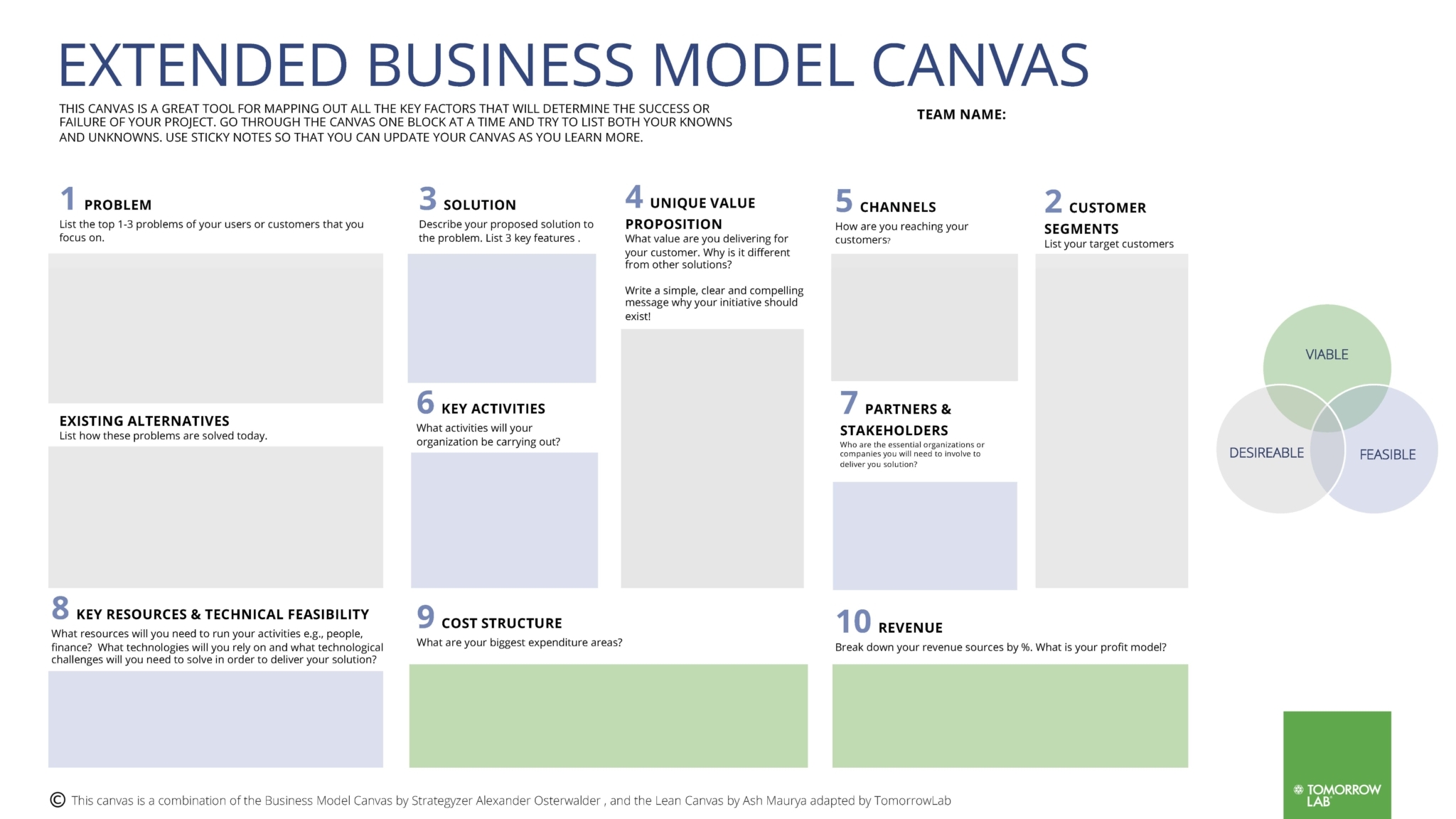Strategyzer’s Business Model Canvas (BMC) is a great tool to map out the crucial elements of your business strategy. Here at TomorrowLab, we use it a lot in customer workshops. Unfortunately, stubborn misconceptions or a lack of knowledge often prevent organisations to get good results with this tool. To make this easier for you, here are six ways to get more out of your BMC sessions.
The Business Model Cavas provides an overview of the different components of your business model: customer segments, value proposition, channels, key activities, key resources, customer relations, partners, and finances (cost structures & revenue streams). You can use the BMC to better understand, design and differentiate your business model in a visual way and by using a common language. The BMC will also help you to generate new business ideas. So, how can you put the Business Model Canvas to use most effectively?
#1 Start with who you are today.
It is interesting to think about how you want to evolve as a company or what you want to focus on in the future. However, you need your current business model as a starting point. It’s important not to mix up your present situation with your future plans, otherwise you will get confused. First, map out your current situation and be honest about it. Then you can stress-test this in different scenarios and see how robust your current model is.
#2 Use numbers and specifics to reveal your current business.
Numbers don’t lie. So, use them to your advantage to get a clear picture of your current business. The beauty of your current business model is that you typically have a lot of data about it. You can use that to get a concrete picture of your business: revenue, customer segment size, number of assets and buildings, customer lifetime value, which customers generate how many sales, etc. Seeing the actual numbers is often eye-opening.
#3 Know your customers and why they buy.
The customer segment and the value proposition are by far the most difficult boxes to fill out. In workshops, they often generate the most debate. The classic way to segment customers is based on things like age and background. But there may be other and better ways to segment your audience. Think about similar needs, lifestyle and buying behavior. Value proposition is all about the value you create for your customers. Why do they really buy from you? They can have emotional, social or practical reasons.
Sometimes customers wrongfully mix up value proposition and mission. Your mission is what you stand for as a company. Value Proposition is about what matters to the customer. The two can be different. Customers sometimes have unexpected reasons to buy from you. Understand those reasons and you are ahead already.
#4 Tell a clear and coherent story.
Your BMC should tell a story. The different building blocks of the Business Model Canvas should tie this story together. This way, you can use the BMC to easily explain your business model, even to people who don’t know anything about your business. A good test is presenting your BMC to friends and colleagues who might not know your company very well. Try to describe all your building blocks concisely, use bullet points or colours. Also, try to avoid abbreviations that are specific to your business. Can't get everything on one canvas? Then use a second page as a legend.
Numbers don’t lie. So, use them to your advantage to get a clear picture of your current business.
Dorien Piessens, TomorrowLab#5 Don’t see your company as an island.
The environment you operate in is constantly impacting your business. The Business Model Canvas addresses this with four building blocks: Market Forces, Key Trends, Industry Forces and Macro-Economic Trends. It’s important to get a clear idea of these building blocks. As they are constantly evolving, you can learn how robust your business model is in a changing environment.
At TomorrowLab, we have a number of ways to look at these external influences, including future trends sessions, our early warning signals methodology and the creation of future scenarios.
#6 Address high uncertainty with the Lean Canvas.
If you have a new business idea that involves high uncertainty, you are better off with the Lean Canvas. Created by Ash Maurya, the Lean Canvas is a simpler approach that focuses on solving problems. It has a number of different fields compared to the BMC: problems, solution, key metrics, and unfair advantage. It also focuses more on the unique value proposition. It forces you to indicate clearly why you are different from other solutions/alternatives. And to write this down in one compelling message.
The Lean Canvas is a good way to first identify the problem you want to solve and then derive your product or service from it. The Business Model Canvas on the other hand provides a complete picture of a business. This usually works better for mapping out an existing business, where you have already validated your initial hypotheses and reduced some of the risks.
Ready to rock your Business Model Canvas?
At TomorrowLab, we have helped many organisations to get a clear view on their business by using the BMC or the Lean Canvas. Sometimes we use the best of both worlds, the Extended Canvas. This is yet another tool that enables you to map out your complete business model.
But at the end of the day, it’s not about the tool, it’s about how you use the tool. This is where we can help. Need some guidance on how to use these tools? We can organize a training where you can learn to get the most out of your Business Model Canvas, Lean Canvas or Extended Canvas.


